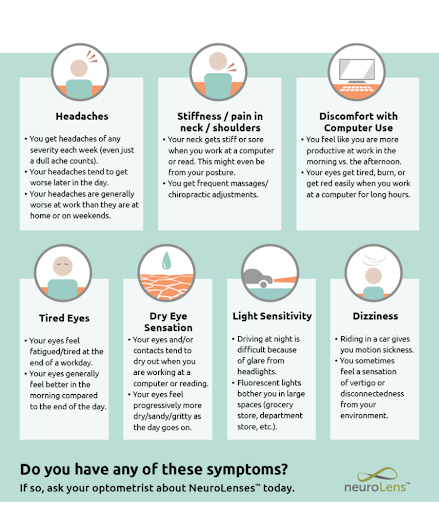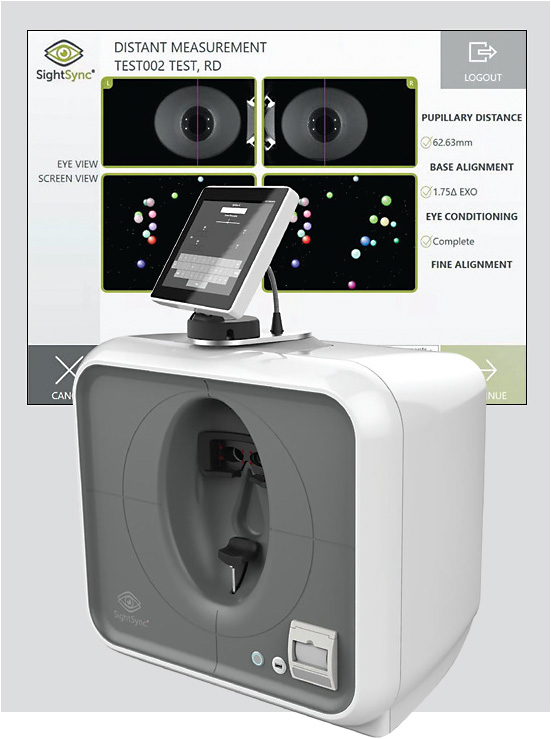Neurolenses Launched for Relief of Headaches, Neck/Shoulder Pain and Eyestrain When Using Digital Devices
eyestrainNeurolensPrescription Lenses
Neurolens announced the introduction of the first and only prescription lenses that add a contoured prism to relieve the headaches, neck/shoulder pain and eyestrain that 65 percent of U.S. adults complain of when using digital devices, reading, or doing detail work.
Years of in-depth clinical research conducted at a neurology center uncovered a surprising link between the eyes and brain. Neurology, optometry, and ophthalmology researchers discovered that a majority of headache patients shared a common trait: a misalignment in their vision that caused specific symptoms when using digital devices, reading or doing near work. A further review of optometric literature, predating the use of digital devices, revealed similar symptoms documented throughout history among people whose work required extended time focusing up-close.
“Interestingly, people rarely suspect that the symptoms they experience when using digital devices, reading or doing detail work, may be related to their eyes. In fact, many don’t even mention their headaches, neck/shoulder pain and other physical symptoms during their annual eye exam,” Dr. Gary Lovcik, Anaheim Hills Optometric Center, Anaheim, California, said in a company news release.

When the eyes are not aligned, the visual system must work constantly to compensate for the misalignment. This can put stress on the trigeminal nerve – the largest and most complex nerve connected to the brain, and the one responsible for head and neck sensations – leading to Trigeminal Dysphoria. Literature states that 90% of patients have a larger misalignment at near than distance.
American adults now spend more than nine hours a day on digital devices. The visual demands of this digital lifestyle have increased the number of people who experience symptoms. neurolenses are designed to bring the eyes into proper alignment, which is essential for comfortable vision. In a survey of patients who purchased neurolenses 93 percent found symptom relief, with 73 percent stating that their symptoms were “substantially reduced” or “basically gone” after 45 days.
“Even though we have used prism for years to help the eyes work together, we can only put a single amount of prism in a pair of glasses”, Dr Rick Peterson says, “that means that the amount of prism we could previously use in glasses would be the same when viewing distance objects and reading things at near”
The Invention of a Contoured Prism
 Long before the eye-brain connection was discovered, some innovative eye doctors would add small amounts of prism to patients’ prescription lenses to make their vision more comfortable. However, a standard prism lens can only address eye alignment at a single distance. Neurolens set out to create a customizable prism lens that could address misalignment at all distances.
Long before the eye-brain connection was discovered, some innovative eye doctors would add small amounts of prism to patients’ prescription lenses to make their vision more comfortable. However, a standard prism lens can only address eye alignment at a single distance. Neurolens set out to create a customizable prism lens that could address misalignment at all distances.
The proprietary neurolens contoured prism provides effortless eye alignment at all distances by gradually increasing the prism from distance to near. More than mere “computer lenses,” which don’t account for eye alignment, neurolenses bring the eyes into alignment to relieve headaches, neck/shoulder pain and eyestrain, among other symptoms.
“In the past, most doctors focused on getting each eye to see well independently. However, equally important is how well the eyes work together that leads to comfortable and accurate visual ability, Dr Rick Peterson reports. “Much like having your shoes on the correct feet, your eyes must be strong independently and must be in sync to allow the very best vision”.
The need for an objective and accurate way to measure eye alignment at all distances led neurolens to develop the neurolens measurement device, which uses breakthrough eye-tracking technology to objectively and accurately measure the degree of eye misalignment at distance and near. During a 3-minute measurement exam, patients focus on a single point while a dynamic display of rotating planets and stars activate peripheral and central vision to measure distance and near eye alignment.
The neurolens device measures the amount of eye misalignment at both distance and near. These unique measurements, with calculations to the one-hundredth of a prism diopter, provide a recommended prescription range for the neurolens contoured prism lens design.


